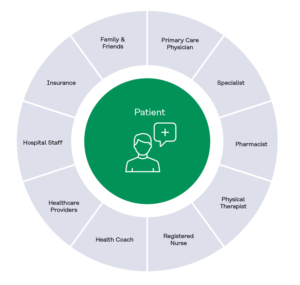I’m Canadian.
Growing up, the comment about healthcare was always, “If you have a cold, Canada’s the place to be. If you have a heart attack, you want to be in the U.S.”
That’s because the U.S. healthcare system excels at addressing acute problems: cancer, heart attacks, major injuries, you get the picture. But hospitals here are increasingly turning into repair shops, the medical equivalent of where you bring your car after an accident or when you hear a weird noise. Is that really how it should be? How effective is that model? What comes after the ER, and how do we prevent recurrences?
We could do so much more for patients if we structured care using a hands-on, ongoing, team-based approach. Imagine what would happen if instead of “Come back and see me in six months,” it was “Talk to you next week.” How much better would patients be at staying on track with their regimens? How much faster would they get – and stay – well? How much more empowered would they be to lead consistently healthy lifestyles?
As a team of technologists and doctors, we’re passionate about this concept. At its heart, it’s really team-based care that puts patients at the center of the process by leveraging technology.
This is how we think about building that technology platform.
Patient-centered care matters more now than ever
The COVID-19 pandemic has demonstrated just how vulnerable chronic conditions make us. Just six percent of all COVID deaths occurred without comorbidities, for example, and we know that just 12 percent of Americans are without added risk factors like “high blood pressure, high cholesterol, diabetes or pre-diabetes…the biggest risk factors for illness and death [beyond age.]”
Those numbers make it clear: there is no more urgent time than right now to rethink our approach to chronic care treatment. With a better strategy, we can absolutely keep people out of hospitals and in their homes, healthy and living their lives as fully as possible. It’s also never been easier to do it.
Telehealth services – as we’ve written about before – are more widely available than ever before due to COVID. The government has opened up more such services through Medicaid and Medicare, insurers are embracing telemedicine (and paying for it), and patient satisfaction is high. Now that virtual medical care is more accessible and affordable, there are fewer barriers to tackling the chronic care management problem effectively.
Patient care as a team sport

In an ideal world, this is a team sport with seasoned players both off the bench and in the game. In fact, this approach to care never involves a 1:1 ratio of doctor to patient. No, it’s about bringing in every single person who can support the patient and aligning them around their care.
It’s about ensuring that at any point, critical information is accessible to all relevant team members. Those involved in that patient’s care should understand the full picture of that person’s health, their history, and the next steps in their treatment regimen.
Hand-offs between care team members should also be seamless. If an escalation occurs, the corresponding care team member should be alerted immediately so they can step on the field and engage with their patient. This removes the burden of the patient needing to schedule and manage their care with the required follow-up designed into the program.
This model of patient care also includes patient preference; the more the patient can feel some meaningful degree of autonomy and investment in their own care and health outcomes, the more successful they can be. Not everyone can leave work, plan for childcare or travel to attend an in-person appointment. Telehealth options expand the range of options available for care teams to check in.
The net of it all is the need to build a community around the patient.
Using technology to keep things on track
Patients need more communication with their healthcare teams – not less – particularly when they’re addressing a chronic or behavioral health issue. The same technology we’re building to keep all care team members focused and on the same page about the patient will also facilitate that communication.
Increasing patient communication is about getting healthcare providers the information they need to do their jobs effectively. This doesn’t need to be an intense, hour-long session every single time. It should be more frequent, lightweight touches through phone calls, video chats, or text messages to track things like blood pressure, weight, symptom management, etc. Tuning the frequency of communication higher increases the likelihood of flagging issues early, which then triggers a predefined escalation plan to alert care team members.
For patients, a more frequent cadence of communication also drives greater patient accountability, which creates a virtuous circle: as patients adhere to their regiments more faithfully, they feel better, and thus are more likely to stick with it.
Healthcare providers have an incredible opportunity to achieve the patient-first care model they want and were trained to deliver. Their desire is plain. The patient need is there. The moment is now. We’re so excited to build the technology that ties them more closely with their patients, makes it easier to deliver care, and produce the health outcomes that are needed.
Learn more about what Welkin does by visiting our product page.
About the Author:
Michelle Pampin is the CEO of Welkin Health, a Care Management platform focused on improving health outcomes for people living with chronic diseases. Michelle is an accomplished leader, with a track record of advancing high-growth Silicon Valley software companies. Michelle speaks three languages: Spanish, French and Portuguese. When she’s not busy leading Welkin, she is busy staying active with her Samoyed, Avi.



